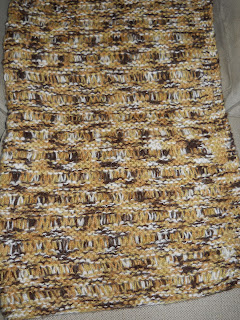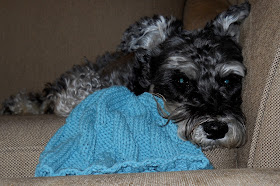I’m frequently asked how to adapt a pattern of mine either
from circulars to flat needles or vice-versa.
When I am going to switch a pattern, I always get out a paper and pen
and work it out before I pick up my needles. I decided that it might be helpful to post something about how
I do it so that everyone can adapt whichever patterns they wish.
 |
| Of course, Schnapps is always helping me too! |
The main difference between the two is that when you knit
flat, you have both a ‘right’ side and a ‘wrong’ side, while knitting in the
round just has ‘right’ side rows.
I’m sure there is a much more elegant description, but this made it easy
for me to understand. When you are
adapting a pattern, you have to change the ‘wrong’ side rows to suit the way
you are knitting. You have to
switch the knit and purl stitches to accommodate the piece.
When adjusting a flat pattern to knitting in the round, it’s
necessary to drop any edge stitches from the pattern, since you will not be
seaming the piece at the end.
When knitting a hat flat, adjusting a circular pattern, I
find it is helpful to add 2 stitches to the total number so that you can have
one knit stitch on either end as a selvedge stitch. This makes seaming the hat so much easier and neater!
For example in the Caterpillar Chemo Cap, the pattern is
written for circular knitting. I’m
going to show you how to adjust it here.
Here is the original pattern:
Cast
on 62 stitches
Row 1: K4, P2, *K6, P2*;
repeat from * to * across row
Row 2: K1, P2, *K6, P2*;
repeat from * to * to last 3, K3
Row 3: K2, P2, *K6, P2*;
repeat from * to * to last 2, K2
Row 4: K3, P2, *K6, P2*;
repeat from * to * to last 1, K1
Row 5: P2, *K6, P2*;
repeat from * to * to last 4, K4
Row 6: Knit all stitches
Adjusted
for Knitting Flat:
Cast on 64 stitches – one edge
stitch for each side.
Row 1 would remain
the same. It is your right side
row. You just need to add the edge stitches.
Row
1: K1 (edge) K4, P2, *K6, P2*;
repeat from
* to * across row to last stitch, K1 (edge)
Row 2, the wrong
side row, would change – reversing knit and purl stitches.
Row
2: K1 (edge) P1, K2, *P6, K2*;
repeat from * to * to last 4, P3, K1 (edge)
Row 3 would remain
the same, since it is also a right side row.
Row
3: K1 (edge), K2, P2, *K6, P2*;
repeat from * to * to last 3, K2, K1 (edge)
Row 4 would reverse
stitches.
Row
4: K1 (edge), P3, K2, *P6, K2*;
repeat from * to * to last 2, P1, K1 (edge)
Row 5, again,
remains the same.
Row
5: K1 (edge), P2, *K6, P2*; repeat
from * to * to last 5, K4, K1 (edge)
Row 6 would reverse
stitches.
Row
6: Purl all stitches
So, all the wrong
side rows knit stitches become purl stitches and purl stitches become knit
stitches. You have added 2
stitches so the first and last stitch of every row will be a knit stitch to
give you a selvedge edge.
If you are adapting
a flat knit to a circular one, the idea is the same; only you drop the edge
stitches. The Basket of Love
Beanie has both patterns posted, so you can look at that to see what I mean as
well. Here is another flat pattern
that I have adapted to show how easily it can be done.
The Stylish Tiles
Hat was posted as a flat knit this way:
Cast on 86 stitches
Row 1:
K1, * K4, P6, K4 *; repeat from * to * to last stitch, K1
Row 2:
Purl all stitches
Row 3:
K1, * K4, P6, K4 *; repeat from * to * to last stitch, K1
Row 4:
K1, * P3, K1, P6, K1, P3 *; repeat from * to * to last stitch, K1
Row 5:
K1, * K2, P1, K8, P1, K2 *; repeat from * to * to last stitch, K1
Row 6:
K1, * P1, K1, P10, K1, P1 *; repeat from * to * to last stitch, K1
Row 7:
K1, * P1, K12, P1 *; repeat from * to * to last stitch, K1
Row 8:
K1, * P1, K1, P10, K1, P1 *; repeat from * to * to last stitch, K1
Row 9:
K1, * K2, P1, K8, P1, K2 *; repeat from * to * to last stitch, K1
Row 10: K1, *P3,
K1, P6, K1, P3 *; repeat from * to * to last stitch, K1
Row 11: K1,
* K4, P6, K4 *; repeat from * to * to last stitch, K1
Row 12:
Purl all stitches
To adjust it to circular knitting, do the following:
Cast on 84 stitches
Row
1 remains the same, minus the first and last knit stitch. It’s the right side.
Row
1: * K4, P6, K4 *; repeat
from * to * to last stitch
Row
2 will switch since it is a wrong side row.
Row
2: Knit all
stitches
Row
3 will stay the same, minus the first and last knit stitch.
Row
3: * K4, P6, K4 *; repeat
from * to * to last stitch
Row 4 will switch.
Row
4: * K3, P1, K6, P1, K3 *;
repeat from * to * to last stitch
Row
5 will stay the same, minus the first and last knit stitch.
Row
5: * K2, P1, K8,
P1, K2 *; repeat from * to * to last stitch
Row
6 will switch.
Row
6: * K1, P1, K10, P1, K1
*; repeat from * to * to last stitch
Row
7 will stay the same, minus the first and last knit stitch.
Row
7: * P1, K12, P1 *; repeat from * to
* to last stitch
Row
8 will switch.
Row
8: * K1, P1, K10, P1, K1
*; repeat from * to * to last stitch
Row
9 will stay the same, minus the first and last knit stitch.
Row
9: * K2, P1, K8, P1, K2 *;
repeat from * to * to last stitch
Row
10 will switch.
Row
10: *K3, P1, K6, P1, K3 *; repeat
from * to * to last stitch
Row
11 will stay the same, minus the first and last knit stitch.
Row
11: * K4, P6, K4 *; repeat from
* to * to last stitch
Row
12 will switch.
Row
12: Knit all stitches
I hope this is clear and easy to understand and that I did
not confuse anyone with my rambling explanations.














